|
The Rochester and Syracuse Railroad was incorporated August 1, 1850, pursuant to Chap. 239,
of the laws of that year, authorizing the consolidation of the Auburn and Syracuse, and Auburn
and Rochester Railroad Companies, by filing the consolidation agreement in the office of thee Secretary of State.
The history of the two consolidating companies up to the date of consolidation is hereinbefore given.
The new Company thus formed constructed the direct line from Syracuse to Rochester, now forming a part
of the main line of the New York Central, and to the making of the consolidation agreement and the
construction of the new road, this chapter will be directed.
Evidently the consolidation act was the result of previous consultation and agreement between the two
companies. Outside parties would not have framed and secured the passage of such an act. They
proceeded with great promptitude to avail themselves of its terms. The articles of association agreed upon by
the directors were not required to be submitted to the stockholders for approval, but there were provisions
requiring the new Company to buy the stock of those shareholders who dissented from the arrangement entered into.
A meeting of the two Boards was called for July 17th, at Syracuse, and the consolidation agreement was made and
signed that day.
The capital stock was fixed at $4,200,000, divided into shares of $100 each. One share of the stock of
the new Company was to be issued for one share of the stock of an old company and adding thereto fifteen percent of stock in the
new Company. The then issued and paid up stock of the consolidating companies was,
|
Auburn and Rochester
|
$2,195,765
|
|
Auburn and Syracuse
|
624,000.00
|
|
Total issued
|
$2,820,765
|
|
15% additional
|
422,114
|
|
TOTAL TO BE ISSUED
|
$3,242,879
|
The consolidation agreement states that, "The said fifteen per cent is to compensate the
stockholders for the amount paid toward the cost of construction of the two Rail Roads
beyond the stock issued."
Fixing the amount of the capital stock in excess of the sum of that of the consolidating companies was
expressly authorized by the consolidation act in the following words,
They shall form articles of association in which shall be set forth ... the amount of the capital stock
of the company, which shall not be less than the aggregate amount of capital stock of the two companies
so uniting ... and the terms upon which the two companies are united in one corporation.
The consolidation act also contemplated the acquisition by the new Company of all the rights and property
of the direct railway between Syracuse and Rochester and the construction of that road as a part of
the consolidated road. This necessitated a capital stock greater than that of the two consolidating
companies. The actual cost of the new road up to June 1, 1853, was $2,001,339.95, with work incomplete
estimated to cost $25,000. The capital stock of $4,200,000 was therefore inadequate by over $1,000,000
to take care of the old stock and the new construction.
The old roads were turned over to the new Company for operation August 1, 1850.
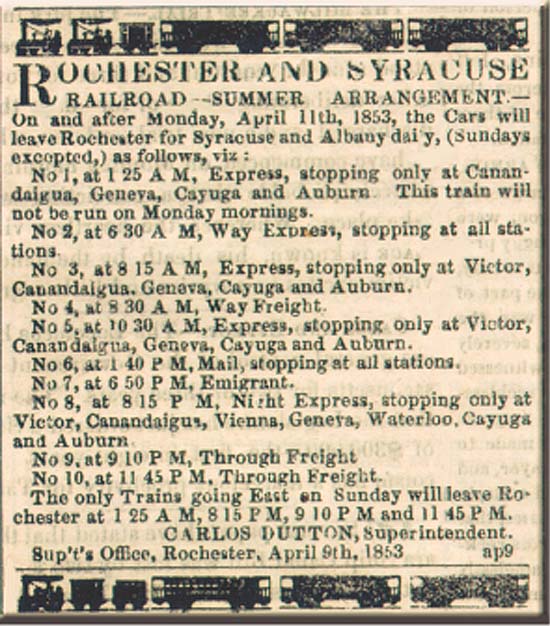
Our attention may now be directed to the direct line between Syracuse and Rochester. Why a railroad
over this route had not been built earlier is unknown. The probable explanation is that the early roads
were projected to meet local needs and not primarily for through traffic. We have learned that the Auburn
and Syracuse was constructed to bring Auburn into close connection with the canal and that the Auburn and
Rochester was located so as to serve the local needs of the villages along the route prescribed by its charter.
It would seem that the villages along the line of the canal between Rochester and Syracuse felt satisfied
with the transportation facilities afforded by it and did not feel like investing local capital in the
untried speculation of an experimental railroad. Circumstances and time wholly changed this feeling, if it
existed. The change was gradual and a new road was long talked of before any active measures were taken to
obtain one. This talk culminated in calling a convention at Lyons in Wayne county August 18, 1847, at which
108 regularly appointed delegates were present from fourteen villages and towns along the route and a few
from other places. The meeting was organized and transacted its affairs in a highly business-like manner through
carefully appointed committees. Various moderate and yet emphatic resolutions favoring the construction of a
railroad along the canal route were adopted. One was that a committee be appointed to draw up a statement in
relation to the propriety, the advantages and the value as an investment of the proposed railroad and that the same
be published and presented to the legislature with the proceedings of the convention. An executive committee
of five from each of four counties was appointed to take charge of an application for a charter. The statement
drawn by the committee was exceedingly persuasive. Attention was directed to every material question involved.
It was pointed out that the Auburn route was 104 miles long, whereas the proposed road wouldd be only about 80;
that the grades on the Auburn route were in places quite long nad heavy, the proposed route was practically level.
But the chief emphasis was placed upon the great through business which it was affirmed was sure to come. The
document is a powerful plea for what soon after became an established fact and it is therefore unnecessary to quote
it even in part.
The result of this movement was that the Direct Railway between Syracuse and Rochester was incorporated
June 18, 1848. It did not, for some reason, materialize into action very successfully. Only 834 shares appear
to have been subscribed, upon which there was paid in $8,340. No route was located, although one was surveyed.
But it remained a menance to the Auburn roads, which they were desirous to control, and accordingly, the consolidation
act authorized the consolidated company to purchase all the property and rights of the Direct Company and to
proceed with the construction of the road. Apparently the whole procedure had been mapped out before the
drafting of the act, for on August 1, 1850, the very day on which the Rochester and Syracuse came into
legal existence, the proper officers of the two roads were at Canandaigua in the office of the Auburn and Rochester
and executed the paper transferring all the rights and property of the Direct road as provided by the statute.
The Rochester and Syracuse agreed to pay therefor to each of the stockholders of the Direct, an amount of stock equal to the
amount held by them respectively in the Direct upon their paying to the Rochester and Syracuse ninety
per cent thereon (they had already paid ten per cent on their Direct stock) or at their option to pay them
the amount htey had paid in in cash. The Direct stockholders elected to take the cash.
The Rochester and Syracuse also agreed to construct the direct line and in one year from the date of the agreement
to expend on the same at least $200,000: the road to be in all respects a first class railroad with iron
superstructure and to be ocmpleted and operated within the time allowed by the consolidation act, namely,
within three years from August 1, 1850. The line which had been surveyed by the Direct was in the main the one to be followed.
The Company proceeded promptly with the work of construction. Mr. James Hall was engaged as chief engineer and
agent. The winter of 1850-51 was employed in surveying the route; its location was fixed by the directors, May 2, 1851.
Grading was commenced shortly after and the whole road was put into operation about June 1, 1853. Some portion of it had been
operated prior to that date sufficiently to yield gross earnings amounting to $2,796.40, according to Mr. Hall's last report.
The total cost, according to Mr. hall, including some unfinished work he estimated would require $25,000 to complete,
was $2,026,339.95, being an average per mile of $25,110.64, without rolling stock, escept gravel cars used in
construction.
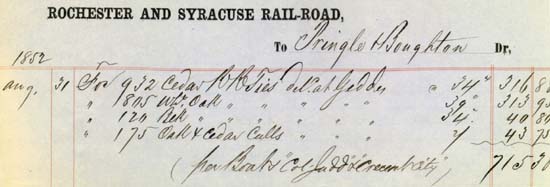
The second and third annual reports of Mr. Hall have survived. He was an engineer who clearly understood that reports to be
valuable must give proper details, and we gain from his a great deal of information of value which gives a pretty clear
idea of unit costs and construction troubles in 1851-52. Some of the more important unit prices were: Iron rails, per ton,
$43; spikes, per ton, $70; wrought iron chairs for rails, 4.75 cents per pound delivered in Syracuse. There were
three hundred and twelve tons of these. Ties, cedar, 38 cents each; oak, 42 cents; chestnut, 38 cents; pine, 40 cents.
These tie prices he declares high owing to the demand on the Rochester, Lockport and Niagara Falls, which was then building.
Excavation prices varied according to character of material. One paragraph reads, "On section sicty, William Barker,
contractor, the excation proved so much harder than was anticipated, that we took the work off his hands and relt it to
Messrs. Candee & Co. at fifty-five cents per yard rather than submit to paying Mr. Barker sixty-five cents, the original
contract price being forty cents." He does not, other than this, state the contract prices, but his estimate
prices were for earth, 16.8 cents, loose rock, 35.8 cents, solid rock, 70 cents, per cubic yard. First class
bridge masonry he estimated at $6.47 per yard, arch masonry $8.26, fencing $1.10 per rod, truss bridging $28 per lineal foot.
Gravel for ballasting cost about 1/3 more than earth excavation due to long haul. Ballasting after commencing
operation he strongly opposes and thinks it would increase the cost at least 33 per cent.
Grading and masonry did not proceed as rapidly as required by contract and his explanation is well worth considering
at the present day.
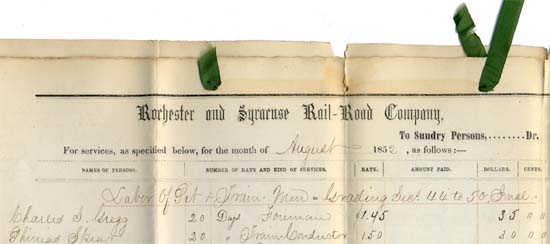
|
The greatest cause for the detention of the grading and masonry, has been the uncommon unfavorableness of the weather
during the past season, for doing work located as this is well known to be, through a section of country in which a very large
proportion of the excavations are to be made in a loamy and common clay soil, and in most cases, indurated
clay subsoil. In sandy and gravelly soils, work can be forwarded with much less detention than in those first
mentioned, to say nothing of the difference in working them, for the reason that in working clayey soils, contractors are
in many cases, after heavy or even comparatively light rains, obliged to suspend their work, for from one to four and five days, in consequence
of the quantity and depth of mud. During this time they are unable to work teams, except at great expense. In sandy
soil this is not the case, as, after rains, however heavy, their work can again be resumed without detention.
A large portion of the road bed has been made from earth taken from side ditches, and borrowing pits taken in the most
convenient places. Many of the swamps and intervals upon the line were partially covered with water for a large portion of the season.
But a very small part of the grading was commenced until late in June. October, November and December,
the months in which very many sections were to have been completed, proved to be very unfavorable for contractors to
forward their work. There were but eight days in the month of November, in which men or horses could possibly be worked.
|
The road, as has been said, was put into operation about June 1, 1853; it was turned over to the New York Central,
August 1 of the same year.
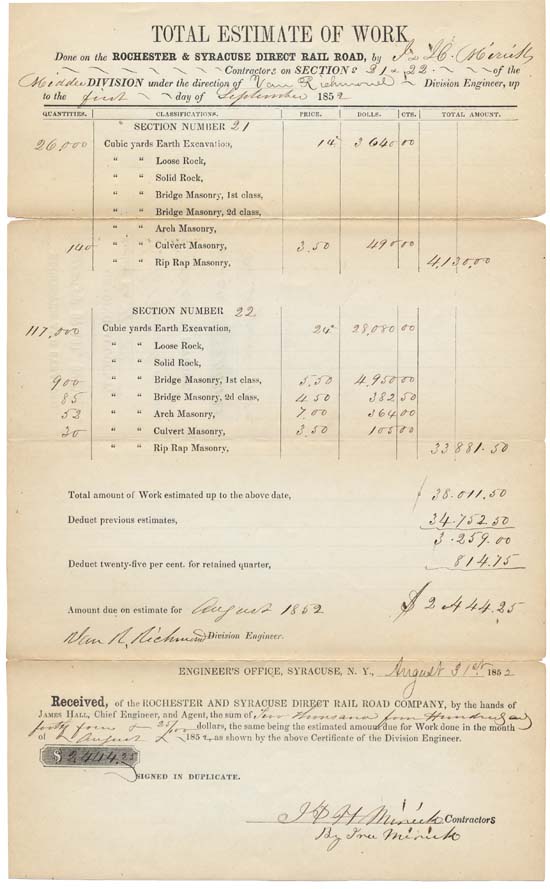
|
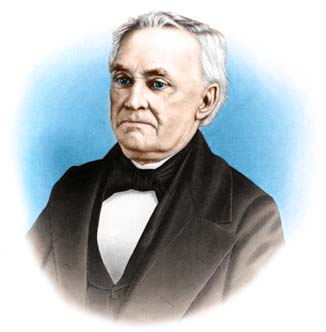





 Copyright © 2003, Mary S. Van Deusen
Copyright © 2003, Mary S. Van Deusen